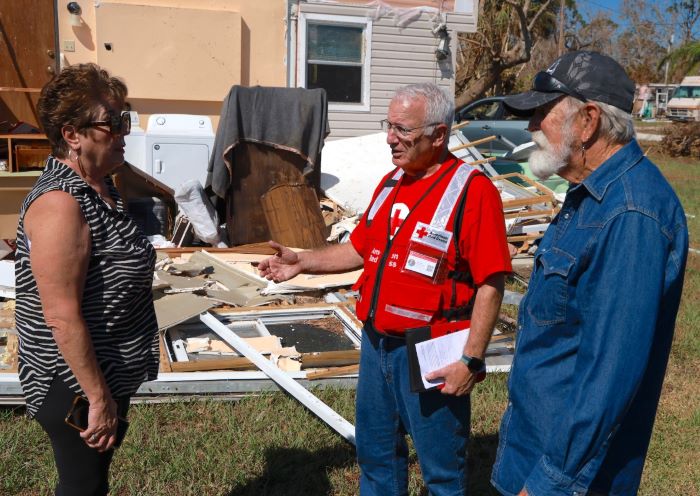
Whether you are deploying to a disaster relief operation for the first time or the tenth time, “You get back way more than you put in. You see the positive impact the Red Cross has,” says volunteer Gary O’Connell. Gary and fellow volunteer, Andy Klein, recently returned from their two-week deployments to Florida to assist after Hurricane Ian ravaged much of the state.
This was Andy’s first out of state deployment, while Gary has deployed 10 times, including regional and long-distance missions in Kentucky and California.
Andy, who is a psychologist, was assigned to the communications team. He flew into Orlando to receive his orientation, mission instructions and meet his 10-person communications cohort.
Within 48-hours of his arrival, however, the operation moved to Fort Myers. They moved the headquarters, operations, relief supplies, Emergency Relief Vehicles, and truck supplies to the new base of operations. At their fairground location, the small “city” hummed with activity. There, 850 Red Crossers and other responders joined in to help families impacted by Hurricane Ian. Thirty-minutes outside the fairground lay the evidence of the storm’s utter destruction.
Andy and his team of communicators would visit disaster relief shelters, talk to shelter managers, ask about the shelter, its Red Cross staff and what they were experiencing. Then they would talk to impacted community members to hear their stories and give them a chance to talk to a sympathetic ear. Andy remembered, in particular, one young family with children. With no place to live, no school, their lives and routines were completely upended. He tried to get a sense of what they were experiencing and to give the sense of hope that is core to the Red Cross mission.
“We spent days out on the road, driving throughout the disaster area, assessing what the hurricane impact meant and how to tell this story, said Andy. People came from other parts of the country to assist survivors of the hurricane in their own special way. For example, one group set up in a Walmart parking lot and 14 other locations to distribute hot meals to hungry families as their way of contributing. “This country is unique, people come out of the woodwork to help others in need. Volunteering is a very American trait, helping your neighbor,” Andy noted and it was on full display in Florida.
A retired civil engineer who lives in Calvert County, Maryland, Gary O’Connell served out of Tampa and stayed with his brother who lives in Cape Coral. A Red Cross volunteer for four years, Gary helped ensure meals were delivered to communities most heavily impacted by the storm. His team worked with Baptist Kitchen Church members, who would cook—and the Red Cross would distribute the food. At a shelter, for example, the food is brought in, and the folks there are fed. At schools or other “fixed sites” as they are called, food is distributed at a set time, 5-6 pm for dinner, for example.
Gary has training in feeding, sheltering, logistics and damage assessment—and is qualified to drive an emergency response vehicle and a fork-lift. However, he pitches in where needed. “The perfect Red Cross volunteer is Gumby. Flexible. You have to be flexible and be willing to do what they need you to do.”
He also encourages volunteers to adjust their expectations. “Your expectations need to be assessed right. Conditions change. It’s a disaster. It looks like chaos, but it works.”
“I tell everyone, if you have the chance, you should deploy at least once,” urges Gary. “When I come back from a deployment, I feel uplifted.”
Through their efforts, Andy, Gary and the more than 70 National Capital & Greater Chesapeake Region volunteers who have already deployed to assist with Ian relief efforts exemplify the Red Cross values of collaboration, compassion and commitment. But we need more volunteers to help.
To learn more about volunteering on a Red Cross disaster relief operation, go to redcross.org/volunteer.